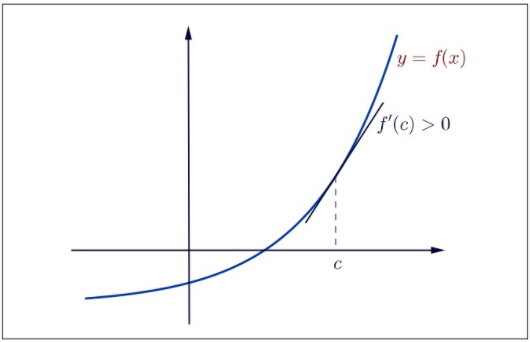4.3: SOME APPLICATIONS OF THE MEAN VALUE THEOREM
- Page ID
- 49115
In this section, we assume that \(a,b \in \mathbb{R}\) and \(a < b\). In the proposition below, we show that it is possible to use the derivative to determine whether a function is constant. The proof is based on the Mean Value Theorem.
Let \(f\) be continuous on \([a,b]\) and differentiable on \((a,b)\). If \(f^{\prime}(x)=0\) for all \(x \in (a,b)\), then \(f\) is constant on \([a,b]\).
- Proof
-
Suppose by contradiction that \(f\) is not constant on \([a,b]\). Then there exist \(a_{1}\) and \(b_{1}\) such that \(a \leq a_{1}<b_{1} \leq b\) and \(f\left(a_{1}\right) \neq f\left(b_{1}\right)\). By Theorem 4.2.3, there exist \(c \in \left(a_{1}, b_{1}\right)\) such that
\[f^{\prime}(c)=\frac{f\left(b_{1}\right)-f\left(a_{1}\right)}{b_{1}-a_{1}} \neq 0,\]
which is a contradiction. \(\square\)
The next application of the Mean Value Theorem concerns developing simple criteria for monotonicity of real-valued functions based on the derivative.
Let \(f\) be differentiable on \((a,b)\).
- If \(f^{\prime}(x)>0\) for all \(x \in (a,b)\), then \(f\) is strictly increasing on \((a,b)\).
- If \(f^{\prime}(x)<0\) for all \(x \in (a,b)\), then \(f\) is strictly decreasing on \((a,b)\).
- Proof
-
Let us prove (i). Fix any \(x_{1}, x_{2} \in(a, b)\) with \(x_{1}<x_{2}\). By Theorem 4.2.3, there exists \(c \in \left(x_{1}, x_{2}\right)\) such that
\[\frac{f\left(x_{2}\right)-f\left(x_{1}\right)}{x_{2}-x_{1}}=f^{\prime}(c)>0.\]
This implies \(f\left(x_{1}\right)<f\left(x_{2}\right)\). Therefore, \(f\) is strictly increasing on \((a,b)\). The proof of (ii) is similar. \(\square\)

Figure \(4.5\): Strictly Increasing Function.
Let \(n \in \mathbb{N}\) and \(f:[0, \infty) \rightarrow \mathbb{R}\) be given by \(f(x)=x^{n}\).
Solution
Then \(f^{\prime}(x)=n x^{n-1}\). Therefore, \(f^{\prime}(x) > 0\) for all \(x > 0\) and, so, \(f\) is strictly increasing. In particular, this shows that every positive real number has exactly one \(n\)-th root (refer to Example 3.4.2).
Suppose \(f\) is differentiable on \(I = (a,b)\) and \(f^{\prime}(x) \neq 0\) for all \(x \in (a,b)\). Then \(f\) is one-to-one, \(f(I)\) is an open interval, and the inverse function \(f^{-1}: f(I) \rightarrow I\) is differentiable. Moreover,
\[\left(f^{-1}\right)^{\prime}(y)=\frac{1}{f^{\prime}(x)},\]
where \(f(x) = y\).
- Proof
-
It follows from Theorem 4.2.5 that
\[f^{\prime}(x)>0 \text { for all } x \in (a,b), \text { or } f^{\prime}(x)<0 \text { for all } x \in (a,b).\]
Suppose \(f^{\prime}(x)>0\) for all \(x \in (a,b)\). Then \(f\) is strictly increasing on this interval and, hence, it is one-to-one. It follows from Theorem 3.4.10 and Remark 3.4.11 that \(f(I)\) is an open interval and \(f^{-1}\) is continuous on \(f(I)\).
It remains to prove the differentiability of the inverse function \(f^{-1}\) and the representation of its derivative (4.7). Fix any \(\bar{y} \in f(I)\) with \(\bar{y} = f(\bar{x})\). Let \(g=f^{-1}\). We will show that
\[\lim _{y \rightarrow \bar{y}} \frac{g(y)-g(\bar{y})}{y-\bar{y}}=\frac{1}{f^{\prime}(\bar{x})}.\]
Fix any sequence \(\left\{y_{k}\right\}\) in \(f(I)\) that converges to \(\bar{y}\) and \(y_{k} \neq \bar{y}\) for every \(k\). For each \(y_{k}\), there exists \(x_{k} \in I\) such that \(f\left(x_{k}\right)=y_{k}\). That is, \(g\left(y_{k}\right)=x_{k}\) for all \(k\). It follows from the continuity of \(g\) that \(\left\{x_{k}\right\}\) converges to \(\bar{x}\). Then
\[\begin{aligned}
\lim _{k \rightarrow \infty} \frac{g\left(y_{k}\right)-g(\bar{y})}{y_{k}-\bar{y}} &=\lim _{k \rightarrow \infty} \frac{x_{k}-\bar{x}}{f\left(x_{k}\right)-f(\bar{x})} \\
&=\lim _{k \rightarrow \infty} \frac{1}{\frac{f\left(x_{k}\right)-f(\bar{x})}{x_{k}-\bar{x}}}=\frac{1}{f^{\prime}(\bar{x})}
\end{aligned}.\]The proof is now complete. \(\square\)
Let \(n \in \mathbb{N}\) and consider the function \(f:(0, \infty) \rightarrow \mathbb{R}\) given by \(f(x)=x^{n}\).
Solution
Then \(f\) is differentiable and \(f^{\prime}(x)=n x^{n-1} \neq 0\) for all \(x \in(0, \infty)\). It is also clear that \(f((0, \infty))=(0, \infty)\). It follows from the Inverse Function Theorem that \(f^{-1}:(0, \infty) \rightarrow(0, \infty)\) is differentiable and given \(y \in(0, \infty)\)
\[\left(f^{-1}\right)^{\prime}(y)=\frac{1}{f^{\prime}\left(f^{-1}(y)\right)}=\frac{1}{n\left(f^{-1}(y)\right)^{n-1}}.\]
Given \(y > 0\), the value \(f^{-1}(y)\) is the unique positive real number whose \(n\)-th power is \(y\). We call \(f^{-1}(y)\) the (positive) \(n\)-th root of \(y\) and denote it by \(\sqrt[n]{y}\). We also obtain the formula
\[\left(f^{-1}\right)^{\prime}(y)=\frac{1}{n(\sqrt[n]{y})^{n-1}}.\]
Exercise \(\PageIndex{1}\)
- Let \(f: \mathbb{R} \rightarrow \mathbb{R}\) be differentiable. Prove that if \(f^{\prime}(x)\) is bounded, then \(f\) is Lipschitz continuous and, in particular, uniformly continuous.
- Give an example of a function \(f:(0, \infty) \rightarrow \mathbb{R}\) which is differentiable and uniformly continuous but such that \(f^{\prime}(x)\) is not bounded.
- Answer
-
Add texts here. Do not delete this text first.
Exercise \(\PageIndex{2}\)
Let \(f: \mathbb{R} \rightarrow \mathbb{R}\). Suppose there exist \(\ell \geq 0\) and \(\alpha > 0\) such that
\[|f(u)-f(v)| \leq \ell|u-v|^{\alpha} \text { for all } u, v \in \mathbb{R}\].
- Prove that \(f\) is uniformly continuous on \(\mathbb{R}\).
- Prove that if \(\alpha > 1\), then \(f\) is a constant function.
- Find a nondifferentiable function that satisfies the condition above for \(\alpha = 1\).
- Answer
-
Add texts here. Do not delete this text first.
Exercise \(\PageIndex{3}\)
Let \(f\) and \(g\) be differentiable functions on \(\mathbb{R}\) such that \(f\left(x_{0}\right)=g\left(x_{0}\right)\) and
\[f^{\prime}(x) \leq g^{\prime}(x) \text { for all } x \geq x_{0}.\]
Prove that
\[f(x) \leq g(x) \text { for all } x \geq x_{0}.\]
- Answer
-
Add texts here. Do not delete this text first.
Exercise \(\PageIndex{4}\)
Let \(f, g: \mathbb{R} \rightarrow \mathbb{R}\) be differentiable functions satisfying
- \(f(0)=g(0)=1\)
- \(f(x)>0, g(x)>0\) and \(\frac{f^{\prime}(x)}{f(x)}>\frac{g^{\prime}(x)}{g(x)}\) for all \(x\).
Prove that
\[\frac{f(1)}{g(1)}>1>\frac{g(1)}{f(1)}.\]
- Answer
-
Add texts here. Do not delete this text first.
Exercise \(\PageIndex{5}\)
Let \(f\) be twice differentiable on an open interval \(I\). Suppose that there exist \(a,b,c \in I\) with \(a < b < c\) such that \(f(a)<f(b)\) and \(f(b)>f(c)\). Prove that exist \(d \in(a, c)\) such that \(f^{\prime \prime}(d)<0\).
- Answer
-
Add texts here. Do not delete this text first.
Exercise \(\PageIndex{6}\)
Prove that the function \(f\) defined in Exercise 4.1.11 is not monotone on any open interval containing \(0\).
- Answer
-
Add texts here. Do not delete this text first.


